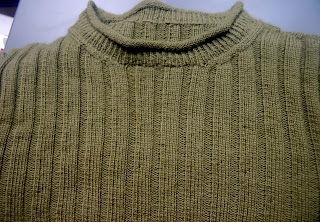Let's talk about Leo
Remember about a year ago, I was
For anyone contemplating making this jumper in the round, I have a few pointers based on my own errors in doing the same.
Kristi Porter, the designer of Leo (published in the Fall 2004 issue of Knitty), really thought about every single detail in designing this jumper, and paid particular attention to the detail of the armhole shaping. You will see the shaping note near the top of the pattern, which gives instructions that all decreases take place 3 stitches in from the edge:
On RS rows, decreases are worked: K3, work 2 tog tbl, work in pattern to last 5 sts, work 2 tog, k3. On WS rows, the decreases are switched accordingly, and the first and last three sts of the row are p3 instead of k3.
In order to establish this 3-stitch column of knit stitches along the armhole shaping on both sides (and, importantly, in order to centre a column of 5 knit sts at the exact middle of both the front and back of the jumper), the rib pattern for both the front and back is set up at the very beginning of the work as K3, (p3, K5) to last 6 sts, then p3, k3. It is important to note that the pattern is not simply 3x5 rib over a multiple of 8 stitches, it is actually 3x5 rib over a multiple of 8 sts PLUS 9.
This has ramifications for modifying the jumper to knit in the round. Normally, when converting a pattern knit back and forth in flat pieces to knit in the round, you deduct a number of stitches, usually 4, because you won't need those stitches for seaming. Then you cast on the remaining number of stitches and start knitting around. So, for example, if the front and back of a pattern require you to cast on 52 stitches each, you can assume (unless mentioned otherwise) that one stitch on either side of each piece is intended to be used in seaming the pieces together. Since you will be working in the round and not requiring a seam, you deduct one stitch at each side of each piece (2 sts for each piece) and cast on a total of 100 sts in order to work the front and back together in the round.
If you follow the same logic when casting on to work Leo in the round, you will not wind up with a multiple of 8 sts PLUS 9. You will wind up with a multiple of 8 sts PLUS 6.
Since I didn't realise this and just bolted off knitting away to my little heart's content, the centre column of 5 knit stitches on Fiver's Leo is off by a bit, as it is on the back. Also, more subtly, although I belatedly established the pattern of 3 knit sts at the edges of the armhole shaping, the column of 3 knit sts does not 'flow' out of the edge column of three knit stitches.
 You can see here that the ribbing is not exactly centred on the neckline. (Compare to this photo on Knitty.)
You can see here that the ribbing is not exactly centred on the neckline. (Compare to this photo on Knitty.) This is the front armhole shaping. If I had followed the instructions, the knit stitches would have flowed up from the ribbing in the area below the armhole. Instead, I had to change a column of purl stitches to knit stitches for the decreases.
This is the front armhole shaping. If I had followed the instructions, the knit stitches would have flowed up from the ribbing in the area below the armhole. Instead, I had to change a column of purl stitches to knit stitches for the decreases.These are minor problems and I'm happy to live with them. Fiver probably has never even noticed them. But if you want to do things right from the start, I recommend the following procudures:
1. Disregard the deduction for seam allowance stitches and knit in the round with one column of 6 knit stitches where the seam would be at both sidese. The drawback to this is it interrupts the flow of 5x3 rib that you will otherwise be knitting. The other minor drawback is that the circumference of the body of the jumper will be 4 stitches larger than intended by the pattern, but in an all-over rib pattern such as this, there is enough give-and-take to make this a minor consideration.
2. Although I haven't thought this out in great detail (and it might not work, you might want to give it some thought before trying it), you could cast on a multiple of 8 stitches only, then start the front with p3, k5 etc, ending the front with a p3; then working the back starting and ending with a k5. As far as I can see on paper, this would result in a centered column of 5 sts for the front, but the back would not have a centred column of 5. If you went with this option, you could somehow 'borrow' 2 knit stitches on either side of the back for your column of knit stitches along the armhole shaping.
3. Disregard all this tendency to perfectionism and knit it with an off-centre column of knit stitches at the middle of both sides and fudge the armhole shaping detail, like I did.
4. Knit it flat. This might help break up the monotony of knit 5, purl 3 (because at least half the time you'd get to purl 5 and knit 3). Also, the side seam does have its advantages in adding structure and stability to a garment that otherwise will have the tendency to grow in length over time.
I hope this has not made Leo sound overly complicated. I found it to be one of the most rewarding knits I've done in recent memory. The all-over rib pattern tested my patience, but the end result is very flattering to the wearer, not to mention comfortable for him, which is the main thing!




<< Home